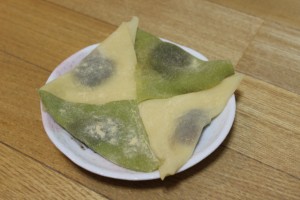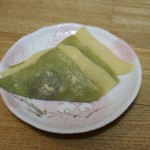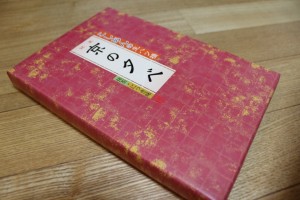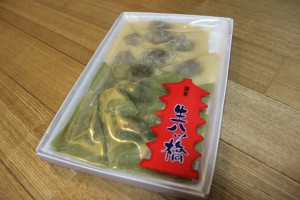Mochi Diaries: Nama Yatsuhashi 生八ã¤æ©‹
 Welcome to Chapter 2 of ‘The Mochi Diaries’ (餅ã®æ—¥è¨˜) ☆〜(ã‚。∂)
Welcome to Chapter 2 of ‘The Mochi Diaries’ (餅ã®æ—¥è¨˜) ☆〜(ã‚。∂)
Today I shall be introducing the original mochi that began my infatuation many years ago during a trip to Kyoto!! Without further ado I present my holy grail of mocha – the triangular, deviously delicious Nama Yatsuhashi 生八ã¤æ©‹!!!!
Nothing screams ‘I’ve just visited Kyoto’ more than bringing back a box of these as omiyage ãŠåœŸç”£. With an origin dating back over 300 years yatsuhashi were named after Yatsuhashi Kengyoå…«æ©‹ æ¤œæ ¡, a famous composer and player of koto (a traditional Japanese 6 stringed instrument) music. He is the man credited with being the first musician to introduce and enlighten the general public to the art of koto, and so he is often regarded as the “Father of Modern Koto.”
Four years after his death in 1685, a vendor near Shogoin Taisha began selling a sweet that was shaped like a koto in his memory. As a baked cookie with ingredients composing of only pounded rice, cinnamon and sugar, it has a very long shelf life of around 3 months. This meant that by the turn of the 20th century Yatsuhashi had become popular as an omiyage gift from Kyoto.
 Now there are two types of yatsuhashi, baked å…«ã¤æ©‹ and unbaked 生八ã¤æ©‹.The un-baked are those of which I am particularly fond of and are called hijiri è– (meaning monk or priest) or nama 生 (raw) yatsuhashi.
Now there are two types of yatsuhashi, baked å…«ã¤æ©‹ and unbaked 生八ã¤æ©‹.The un-baked are those of which I am particularly fond of and are called hijiri è– (meaning monk or priest) or nama 生 (raw) yatsuhashi.
The soft hijiri/nama kind began to be sold in the 1960’s. When making this variety instead of baking the dough, it is steamed, flattened and cut into little squares. Azuki å°è±† (red bean paste) is then placed in the centre of each piece and folded into a triangle, not dissimilar to ravioli.
If you actually look at the packaging I found the writing is a little amusing, alongside the name namayatsuhashi 生八橋 these mochi are also regionally known as O-Tabe ãŠé£Ÿã¹(lit. please eat). On these particular ones the name written on the box is kyounotabe 京ã®ã‚¿ãƒ™, although this literally translates to ‘Capital Eat’ the meaning is something more akin to Kyoto Yatsuhashi.
 Upon opening the box I was presented with a box being half filled with lightly brown coloured triangular sweets and the other half a pale green, these correspond to the flavours which are nikkei 肉桂 (cinnamon) and matcha抹茶 (green tea). That said the centre of both consists of the same koshian 漉ã—餡 (red bean paste) filling.
Upon opening the box I was presented with a box being half filled with lightly brown coloured triangular sweets and the other half a pale green, these correspond to the flavours which are nikkei 肉桂 (cinnamon) and matcha抹茶 (green tea). That said the centre of both consists of the same koshian 漉ã—餡 (red bean paste) filling.
Now these are the most standard and plainly flavoured yatsuhashi (they in fact come in dozens of seasonal and regional varieties), however they are a time tested favourite amongst the Japanese. Having tried these sweets a decade ago when I visited Kyoto as an exchange student, indulging in the soft, delicate texture complimented by the mildly sweetened koshian centre, my senses were overwhelmed and mind flooded with bitter-sweet nostalgia.
To this day, in my opinion yatsuhashi represent the perfect mochi culinary experience, biting into one is infatuating enough to take you to a whole new world of wagashi heaven, if you ever find yourself around Kyoto keep an eye out for them!!




